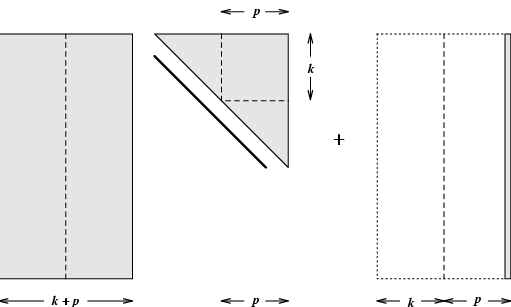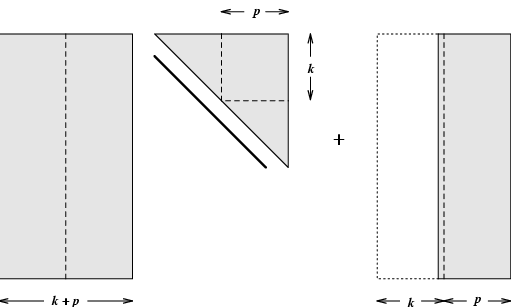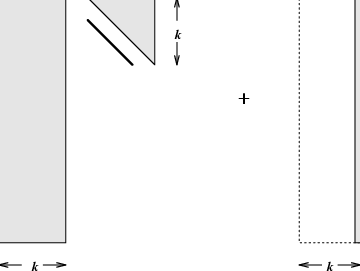The ARPACK software is based upon another approach to restarting that offers a more efficient and numerically stable formulation. This approach called implicit restarting is a technique for combining the implicitly shifted QR scheme with a k-step Arnoldi or Lanczos factorization to obtain a truncated form of the implicitly shifted QR-iteration. The numerical difficulties and storage problems normally associated with Arnoldi and Lanczos processes are avoided. The algorithm is capable of computing a few (k) eigenvalues with user specified features such as largest real part or largest magnitude using storage. No auxiliary storage is required. The computed Schur basis vectors for the desired k-dimensional eigen-space are numerically orthogonal to working precision. The suitability of this method for the development of mathematical software stems from this concise and automatic treatment of the primary difficulties with the Arnoldi/Lanczos process.
Implicit restarting provides a means to extract interesting information from large Krylov subspaces while avoiding the storage and numerical difficulties associated with the standard approach. It does this by continually compressing the interesting information into a fixed size k-dimensional subspace. This is accomplished through the implicitly shifted QR mechanism. An Arnoldi factorization of length m = k+p
| (2) |
| (3) |
| (4) |
Each of these shift cycles results in the implicit application of a
polynomial in ![]() of degree p to
the starting vector.
of degree p to
the starting vector.
The choice of shifts and hence construction of the polynomial is motivated by the fact that if the starting vector where ,then , and thus will provide an orthonormal basis for the invariant subspace Moreover, the spectrum of will be the desired eigenvalues:
For
(a3.3)
(a3.7)
(a3.8) Beginning with the
Input: (
![]() ) with
) with
![]() ,
an
,
an ![]() -step Arnoldi factorization;
-step Arnoldi factorization;
![]() until
until ![]()
End_For
(a3.2) Compute
![]() and select set of
and select set of ![]() shifts
shifts
![]()
based upon
![]() or perhaps other information;
or perhaps other information;
![]()
(a3.4) For ![]() ,
,
Factor
![]() ;
;
![]() ;
;
![]() ;
;
End_For
(a3.5)
![]()
![]()
(a3.6)
![]() ;
;
![]()
![]() -step Arnoldi factorization
-step Arnoldi factorization
![]() ,
,
apply ![]() additional steps of the Arnoldi
process
additional steps of the Arnoldi
process
to obtain a new ![]() -step Arnoldi factorization
-step Arnoldi factorization
![]() .
.

|

|

|
The repeated update of the starting vector through
implicit restarting is
designed to enhance the components of this vector in the directions of the
wanted eigenvectors and damp its components in the unwanted directions.
If has an expansion as a linear combination of eigenvectors
of ![]() , the effect of this
polynomial restarting is illustrated as
follows:
, the effect of this
polynomial restarting is illustrated as
follows:
The basic iteration is listed in Figure 4.4 as Algorithm 3 and the diagrams in Figures 4.5--4.7 describe how this iteration proceeds schematically. In Algorithm 3 and in the discussion that follows, the notation denotes the leading submatrix of
We illustrate a typical polynomial that was constructed during an iteration
on a matrix ![]() that is a small example of a turbine model. The goal was
to compute the five eigenvalues of largest real part of this order 375 matrix.
The surface shown in Figure 4.8 is the plotted over a region containing the spectrum of
that is a small example of a turbine model. The goal was
to compute the five eigenvalues of largest real part of this order 375 matrix.
The surface shown in Figure 4.8 is the plotted over a region containing the spectrum of ![]() . Here, is the
product of all of the filter polynomials constructed during the course
of the iteration. The degree of is around 600 and this would be
quite challenging to apply directly. The ``+" signs are the
eigenvalues of
. Here, is the
product of all of the filter polynomials constructed during the course
of the iteration. The degree of is around 600 and this would be
quite challenging to apply directly. The ``+" signs are the
eigenvalues of ![]() in the complex plane and the contours are the level curves
of . The circled plus signs are the converged eigenvalues
including two complex conjugate pairs and on real root of largest real part.
Observe how well the the location of the unwanted portion of the spectrum
was determined and damped during the course of the iteration.
The figure illustrates that this method can isolate desired eigenvalues on the
``boundary" of the spectrum even though they may be quite close to other eigenvalues.
However, when the clustering becomes pronounced, it will be very difficult to
achieve this.
in the complex plane and the contours are the level curves
of . The circled plus signs are the converged eigenvalues
including two complex conjugate pairs and on real root of largest real part.
Observe how well the the location of the unwanted portion of the spectrum
was determined and damped during the course of the iteration.
The figure illustrates that this method can isolate desired eigenvalues on the
``boundary" of the spectrum even though they may be quite close to other eigenvalues.
However, when the clustering becomes pronounced, it will be very difficult to
achieve this.
Observe that if m = n then and this iteration is precisely the same as the Implicitly Shifted QR iteration. Even for m < n, the first k columns of and the Hessenberg submatrix are mathematically equivalent to the matrices that would appear in the full Implicitly Shifted QR iteration using the same shifts In this sense, the Implicitly Restarted Arnoldi method may be viewed as a truncation of the Implicitly Shifted QR iteration. See [23] for details on a connection with subspace iteration and the QR algorithm. The fundamental difference is that the standard Implicitly Shifted QR iteration selects shifts to drive subdiagonal elements of to zero from the bottom up while the shift selection in the Implicitly Restarted Arnoldi method is made to drive subdiagonal elements of to zero from the top down.
Important implementation details concerning the deflation (setting to zero) of subdiagonal elements of and the purging of unwanted but converged Ritz values are beyond the scope of this discussion. However, these details are extremely important to the success of this iteration in difficult cases. Complete details of these numerical refinements may be found in [26,22].
The above iteration can be used to apply any known polynomial restart. If the roots of the polynomial are not known there is an alternative implementation that only requires one to compute where is the desired degree p polynomial. A sequence of Householder transformations may developed to form a unitary matrix such that and is upper Hessenberg. The details which follow standard developments for the Implicitly Shifted QR iteration will be omitted here.
A shift selection strategy that has proved successful in practice
and is used as the default in ARPACK is
called the ``Exact Shift Strategy". In this strategy, one computes
and sorts this into two
disjoint sets and
The k Ritz values in the
set are regarded as approximations to the ``wanted"
eigenvalues of ![]() , and the p Ritz
values in the set are taken as the shifts .
An interesting consequence (in exact
arithmetic) is that after Step (a3.4) above, the spectrum of in
Step (a3.6) is and the updated starting
vector is a particular linear combination of the k Ritz vectors associated
with these Ritz values. In other words, the implicit restarting scheme
with exact shifts provides a specific selection of expansion
coefficients for a new starting vector as a linear combination
of the current best estimates (the Ritz vectors) for wanted eigenvectors.
This implicit scheme costs p
rather than the k+p matrix-vector products the explicit scheme would
require. Thus the exact shift strategy can be viewed both as
a means to damp unwanted components from the starting vector
and also as directly forcing the starting vector to be a
linear combination of wanted eigenvectors.
See [23,44] for information on the convergence of
IRAM and [3,45] for other possible shift strategies for Hermitian
The reader is referred to [25,33] for studies
comparing implicit restarting with other schemes.
, and the p Ritz
values in the set are taken as the shifts .
An interesting consequence (in exact
arithmetic) is that after Step (a3.4) above, the spectrum of in
Step (a3.6) is and the updated starting
vector is a particular linear combination of the k Ritz vectors associated
with these Ritz values. In other words, the implicit restarting scheme
with exact shifts provides a specific selection of expansion
coefficients for a new starting vector as a linear combination
of the current best estimates (the Ritz vectors) for wanted eigenvectors.
This implicit scheme costs p
rather than the k+p matrix-vector products the explicit scheme would
require. Thus the exact shift strategy can be viewed both as
a means to damp unwanted components from the starting vector
and also as directly forcing the starting vector to be a
linear combination of wanted eigenvectors.
See [23,44] for information on the convergence of
IRAM and [3,45] for other possible shift strategies for Hermitian
The reader is referred to [25,33] for studies
comparing implicit restarting with other schemes.